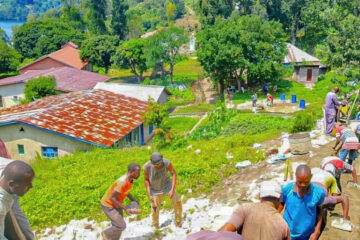Patmos Island Children’s Village – Democratic Republic of Congo
What would cause a mother, clutching her small baby, to quietly creep into the dark night, find a secluded spot, release her grasp on the baby and place it all alone on the cold ground before slipping away? One can only imagine the desperate circumstances such a mother faced as she abandoned her child within a few feet of one of ICC’s children’s homes in the Democratic Republic of Congo (DRC).
When the baby was discovered, he was crying, covered with an old piece of cloth and shaking because of the cold night air. Immediately, he was brought into one of the homes, clothed in a clean outfit and warmed.
In the morning, the staff located a neighbor mother who could feed the child while milk and other supplies needed to help the child survive were purchased in a nearby village. The administrator wrote letters to local community leaders trying to locate the baby’s mother. All these efforts proved unsuccessful, and that is how baby Isaac* became a part of the ICC family.
The DRC is a study in contrasts. While the country is rich in natural resources, having extensive deposits of precious minerals and vast tropical forests, corruption and tribal wars have created extreme poverty and lead to the loss of lives of millions of DRC’s citizens. Often it is the very young who suffer the most.
ICC became aware of the plight of these children through Dr. Barry Wecker, a Canadian. Dr. Wecker had met with the director of an organization in the DRC called PROLASA, which was formed to build and operate medical clinics. This organization faced the reality of the children’s condition in this country. In the eastern region, in the city of Goma, children were brought to them for medical treatment but because they had no parents or homes, PROLASA started to take them in and care for them physically. Many of these children were on the verge of death from malnutrition. PROLASA staff did the best they could, but pretty soon it was beyond their capability to fund and care for these children. The children had been staying in local foster homes, but these families were displaced themselves because of war and couldn’t continue to feed even one more mouth.
At the end of 200l, PROLASA contacted ICC, through Dr. Wecker, to see if there was any possibility that ICC could help. PROLASA had already turned over the children ages 10-12 to the Red Cross. Now they were left with approximately 200 children under 10 years of age. ICC administration told PROLASA that the project would be studied and more information was needed.
To make matters even worse for the people of Goma, a few weeks after PROLASA contacted ICC, tragedy hit again. On January 17, 2002, Mt. Nyiragongo erupted, forcing thousands of people to flee Goma. The lava flow destroyed most of the city and cut the international airport runway in half.
In May of 2002 an ICC team made a trip to Africa and stopped in Kigali Rwanda to meet with a delegation from Goma to hear more about the situation. It was felt at that time that is was still too risky politically to go into Congo. The ICC team decided that emergency measures needed to be taken immediately, so they committed a limited amount of funds to help. There were 40 children who were at risk of dying from malnutrition in the next 3 month if nothing was done. Another 40 would be in that same condition within 4 months. Assisting these children was the beginning of ICC’s work in the DRC.

A short time later, a site was located on the Island of Idjwi in the middle of Lake Kivu, where a children’s village could be constructed as a safe haven for orphaned children. Looking back, this site has proved to be a real blessing as wars never seem to reach this island. Land was donated and soon temporary buildings were put up to house the children on the island. Two classrooms were built to conduct school. A clinic and visitors quarters were also erected. The conditions were a great improvement, but there was still much to be done. The children were sleeping four per bed and only had one outfit of clothing to wear. They at least had food to eat and their medical needs met.
Since those early beginnings several children’s homes have been constructed as funds have been donated. The children’s basic needs are supplied. Other developments have included building permanent structures for the campus church and secondary school as well as campus agriculture and industries such as block making.
This project is ICC’s largest in terms of numbers of children. The needs are great in this country. As funds allow, ICC will continue to develop this children’s village so that even more orphaned and abandoned children can experience the joy of being a part of the ICC family.
More information about the Patmos Island Children’s Village is available
by contacting ICC at (800) 422-7729.
* Name has been changed to protect the child’s privacy


